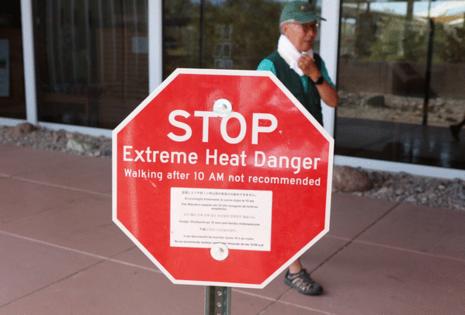F.D. Flam: It's officially hotter than anytime since the birth of Jesus
Published in Op Eds
It’s one thing to say the Northern Hemisphere summer of 2023 was the hottest of the 150 years people have been making measurements. This well-documented claim is often dismissed by skeptics of global warming who point out that the Earth has a long history of temperature fluctuations. That’s why it’s important that a new paper shows last summer was actually the hottest in the last 2,000 years — and that our current temperatures are even more of an outlier than we realized.
If all we had were the few decades of temperature readings to understand the past climate, we wouldn’t know whether our current warming was a major shift or a run-of-the-mill blip. Tree rings hold records that can go back thousands of years, giving us the perspective we need to understand what’s happening today.
In a paper published in Nature this week, scientists used tree rings not only to show long-term trends, but to plot Northern Hemisphere summer temperatures year by year for the last two millennia. 2023 was the hottest of them all. The next hottest 25 have all occurred since 1996. The next runner-up was way back in 246 CE.
The world’s understanding of global warming changed dramatically when scientists started to document long-term temperature trends using tree rings, ice cores, sediment layers and other natural temperature monitors. In 1998, scientists published the famous “hockey stick graph” covering the last 600 years. It showed that global temperatures rose and fell like gently rolling hills until the mid-20th century, when they suddenly soared.
That gave people a graphic image of just how unusual things are today. Unable to discredit the results, some people tried to discredit the researchers by hacking into their emails in 2009 and taking statements out of context to imply they’d done something wrong — creating a phony scandal called “climate-gate.”
Since then, there have been dozens of more detailed or further-reaching reconstructions of our climate history. This latest one covers only the part of the globe that has the most trees — the mid-latitude Northern Hemisphere — but it goes back in fine-grained detail 2,000 years and highlights climate change today in the context of centuries of natural variability.
Even seemingly small fluctuations can have a big impact on human life. Take 536 CE, dubbed “the worst year to be alive” by historian Michael McCormick. An Icelandic volcano erupted, spewing particles into the atmosphere and veiling much of Europe and Asia with a strange, dark fog. That caused cold, famines and a wave of plague that coincided with the collapse of the Eastern Roman Empire. The new Nature paper shows the temperature that summer that year was just 1.9 C below the long-term average and 3.9 C colder than then summer of 2023.
Volcanoes have usually been to blame for cooler years. But the cause of past warm spells is not as well understood. The year 246 CE was also unusually warm. More recently, the Medieval warm period, between 800 CE and 1400 CE, allowed orchards and pastures to spread into Northern Europe, Iceland and Greenland — and also triggered megadroughts, famine and collapse of civilizations in the American Southwest.
Tree rings are allowing scientists to decipher the role of climate in that period and others throughout history. The oldest trees — bristlecone pines — can live nearly 5,000 years; scientists can extract a pencil-thin core to study the rings without harming the trees. But researchers don’t have to use such ancient trees to explore the distant past because they can also read information from rings in wood that’s been incorporated into old buildings, ships or preserved in bogs.
Trees growing in cold conditions can reveal temperature history because temperature is the main factor limiting their growth. The new study depended on such trees in nine different sites analyzed by 15 different teams, said the lead author, Jan Esper of Johannes Gutenberg University in Germany.
Esper said he was interested in better understanding what the Earth’s temperature was like in the pre-industrial area, before human-generated emissions started warming the planet. The Intergovernmental Panel on Climate Change defines pre-industrial temperature as the average measured from 1850 to 1900. The Paris Agreement makes it a goal to keep global temperatures within 1.5 C of that pre-industrial period — a threshold we’re close to exceeding.
But measurements before 1900 were sparse, and Esper says the tree rings suggest the actual pre-industrial era was a bit cooler. From 1850 to 1900, temperatures were already about a quarter of a degree warmer than the average over the previous 2,000 years. That means our current temperatures might be more abnormally warm than we realized.Ray Bradley, a climatologist of the University of Massachusetts, Amherst, was an author on the original hockey stick paper. He said the new paper and the initial hockey stick paper use different techniques and are asking different questions, but both show us how our current era fits into the bigger sweep of time.
“You often hear politicians — ignorant politicians — saying climate varies and it’s been warmer in the past so don’t get too excited about all this greenhouse gas we’re putting into the atmosphere,” said Bradley. But the natural records suggest it hasn’t been this warm in 2,000 years, maybe longer, “so that’s a pretty exceptional situation.”
Exceptional but not hopeless — climatologists say it’s not too late to keep global warming within a manageable range. If we listen to what nature is telling us, we can keep 536 CE as the worst year to be alive.
____
This column does not necessarily reflect the opinion of the editorial board or Bloomberg LP and its owners.
F.D. Flam is a Bloomberg Opinion columnist covering science. She is host of the “Follow the Science” podcast.
©2024 Bloomberg L.P. Visit bloomberg.com/opinion. Distributed by Tribune Content Agency, LLC.







Comments